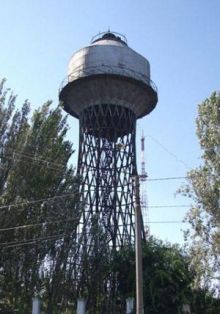Following the publication of The Day (Engineer Shukhov’s masterpiece in Mykolaiv from August 14, 2012) featuring the story about the Shukhov Tower in Mykolaiv, local history fans activated.
Marketing experts on numerous brand-sessions, which were held in Mykolaiv press club, even suggested that Shukhov’s Tower should be considered as a “tourist diamond” of the city, similar to the Eiffel Tower. In summer a new community initiative got organized through one of the popular computer social networks. Their goal is to protect the tower and find out more about it through an organized tour. There appeared lots of pictures with the openwork Shukhov’s Tower in Mykolaiv in the background. The place of headhunters, who descended into the dungeons of the old Mykolaiv, was taken by young residents of Mykolaiv, who go to the Tower with research missions. This is now a popular trend. Unfortunately, the part of the tower which is above the ground is in worse condition than what’s left of it underground. And it is nearly impossible to take up to the balcony around the tank without special climbing equipment.
Fulfillment of the ambitious task of including Shukhov’s Tower in UNESCO World Heritage List is something that can really help to restore and preserve the old model of engineering from the industrial era.
In 2011, thanks to the persistence of Taras Kremin Mykolaiv was included in the international project “Engineering Art of Early Modern. Shukhov’s Strategy in the Design of Light Metal Structures.” The participants of this project are the leading universities in Germany (Technische Universitaet Muenchen), Austria (Universitaet Innsbruck), and Switzerland (ETH Zurich). Professor Andrii Kutny, expert on ancient architecture (he drafted the project for protection and conservation of wooden churches in western Ukraine), winner of Europa Nostra, took an active part in the implementation of this project with the support of the project’s cooperation partner – the Karpenko Physico-Mechanical Institute, National Academy of Sciences (curator – Professor Hryhorii Nikiforchyn). In August of 2012 experts examined the vulnerable spots of the water tower construction caused by corrosion aggressive environment, studied the defectiveness of metals, determined its structure and mechanical properties. Soon there will be recommendations ready for the preservation of structural strength of the Ukrainian masterpiece designed by Vladimir Shukhov. And if the reconstruction works will be carried out so that there will be no changes made to the authentic look of the tower, it can get on the UNESCO list as a monument of the industrial architecture of global significance.
According to Professor Nikiforchyn, today the constructions of the “hyperboloid tower” type designed by Shukhov are not only a monument of the brilliant solution for minimizing metal usage in mesh tower designs, but also serve as a prototype for modern high-rise buildings in many parts of the world, from China to Canada.
In Ukraine there is a number of sites that require immediate examination and, given their technical condition, require the development of a conceptual method of preservation and possible life extension. Our country is involved in solving the problem within the framework of the project initiated by the Foundation for Fundamental Research of the State Agency on Science, Innovations, and Informatization of Ukraine. The peculiarity of this research is the preemptive use of non-destructive monitoring of structures that were built more than a century ago, when the technology of metal production was radically different from what is done today.
The preliminary examination of the technical condition of the oldest water tower in Ukraine has been completed. In particular, the experts found out that studded tower, restored using welding techniques that were used during the construction of the tower, requires another expertise to assess the performance of both riveted and welded connections. Besides, the experts found that leaky catch water tank, pressure pipes, observation deck, and individual elements of the design require immediate repair.
Given the continuity of the destruction, according to the researchers, the tower may soon collapse: the past 105 years were too harsh on it.
Museum workers have not yet spoken publicly about the idea of making the tower an exhibit of the polytechnic section of the exposition. Today all the historical exhibits of the city are taken to the new ethnographical museum “Old Fleet Barracks.” There is lots of space to place everything there. But it is obvious that the tower would not survive another transformation. It must remain at the highest topographic point of the peninsula, and residents of Mykolaiv will be coming to “their tower.”







